Breaking Down JPMorgan, Citi & Big Bank Earnings
For the second quarter in a row, the market reacted favorably to Citigroup’s (C - Free Report) quarterly earnings report after showing its collective disappointment with what it saw from JPMorgan (JPM - Free Report). Partly driving this divergence is Citi’s earlier underperformance, reflecting persistent company-specific operational challenges that likely framed market expectations. That said, parts of the Citi report were notably better than what JPMorgan came out with.
Citi handily beat top-and bottom-line estimates, unlike JPMorgan which missed on both.
Both JPMorgan and Citi showed strength in Main Street banking, helping partly offset weakness in Wall Street activities.
The market knew that investment banking activities like M&A, IPOs, etc. would be down in Q2, while trading activities will be above the year-earlier level. JPMorgan’s investment banking revenues were down -54% in Q2, with Citi’s down -46%. On the trading front, JPMorgan’s Q2 trading revenues were up +15% while the same at Citi were up +25%.
Both JPMorgan and Citi showed positive momentum in their loan portfolios and net interest margins, with net interest income up big. Spending on Chase credit cards was up +21% while Citi cards increased +16%.
Mortgages were down across the board, a function of rising interest rates. This impacted Wells Fargo (WFC - Free Report) more than others given its standing as the country’s largest mortgage lender. Mortgage originations were down -46% at JPMorgan and -36% at Wells.
Overall, 2022 Q2 earnings at JPMorgan, Citi, and Wells Fargo were down -27.6%, -22.9%, and -48.4% from the same period last year, respectively.
While the weakness in investment banking and mortgages contributed to the big year-over-year declines, the biggest driver were loan loss provisions. Each of these three banks set aside small amounts under that heading in 2022 Q2, which compare to very big reserve releases in the year-earlier period. Just to give you an example, Citi booked $375 million in provisions in 2022 Q2 while it released $2.4 billion in the year-earlier period.
For the Zacks Major Banks industry, which includes Citi and JPMorgan and accounts for roughly 40% of total Finance sector earnings, total Q2 earnings are on track to be down -28.2% from the same period last year on +2.1% higher revenues.
Had it not been for the high reserve releases in the year-earlier period, Q2 earnings for the industry would be essentially flat.
The table below shows the sector’s Q2 earnings and revenue expectations at the ‘medium’ industry level in the context of what the space reported in the preceding period and what is expected in the following quarter.
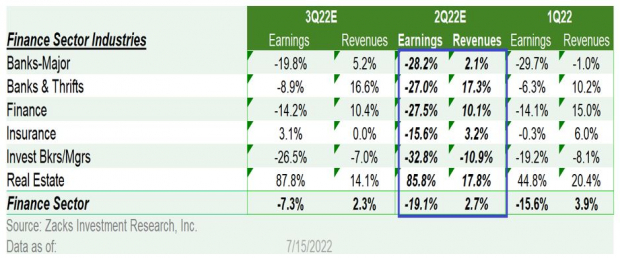
Image Source: Zacks Investment Research
The chart below shows the year-to-date performance of Citi (green line, down -17.3%), JPMorgan (blue line, down -28.6%), and the S&P 500 index (red line, down -20.7%) in the year-to-date period.
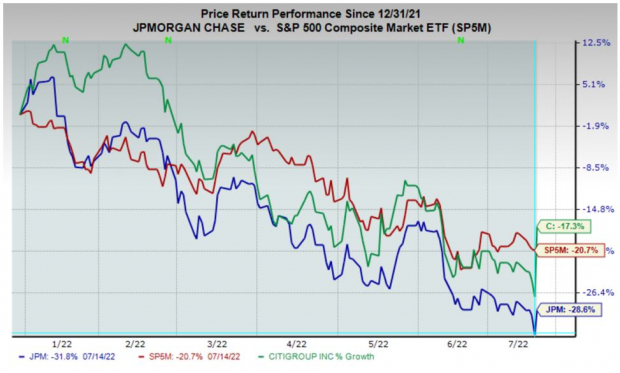
Image Source: Zacks Investment Research
As you can see above, Citi shares have held up better this year, but the picture is starkly different on a longer time horizon, reflecting the stock’s recent catch-up movement.
Why the Downbeat Sentiment on Bank Stocks?
Given the cyclical orientation of the banking business, they remain vulnerable to the rising recession risks to the economy. We don’t think a recession is imminent, but the fear is that a prolonged and aggressive Fed tightening cycle will push the U.S. economy into a recession. This risk is showing up in the flattening yield curve, with the yield difference (or spread) between 2- and 10-year treasury bonds currently in ‘inverted’ shape.
I wouldn’t repeat why yield curve inversions are scary things and why it’s useful for all of us to keep a close on the risk of such a development. But I do want to point out here that I am sympathetic to the view that the current yield curve and its signaling power about future economic growth may not be fully comparable to historical periods as a result of the Fed’s extraordinary QE policies since the global financial crisis.
Irrespective of this plausible but otherwise minority view of the yield inversion, they are a net negative for the growth outlook. This, coupled with elevated oil prices and the geopolitical uncertainty resulting from the Ukraine war appear to be weighing on bank stocks lately.
As is typically the case, the sentiment shift on banks has likely overshot to the downside, as the economy still remains strong even though recessionary risks have increased from very depressed levels.
We see bank stocks as attractively positioned currently on valuation grounds as well, as the chart below that shows the forward 12-month PE multiple for the Zacks Major Banks industry relative to the S&P 500 index.
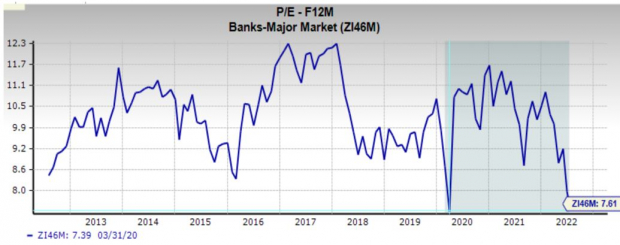
Image Source: Zacks Investment Research
As you can see, the group is currently trading at 7.6X, which compares to a 10-year low of 7.3X in the immediate aftermath of the pandemic in March 2020. These valuation multiples make no sense unless there is a recession on the horizon.
Bank Earnings Scorecard
With respect to the sector’s Q2 earnings season scorecard, we now have results from 23.4% of the sector’s market capitalization in the S&P 500 index. Total earnings for these Finance sector companies are down -27.9% from the same period last year on -0.3% lower revenues, with 54.5% beating EPS estimates and 45.5% beating revenue estimates.
This is a weaker showing than we have seen from this group of banks in other recent periods, as you can see in the comparison charts below that show how Q2 EPS and revenue beats percentages stack up to other recent periods.
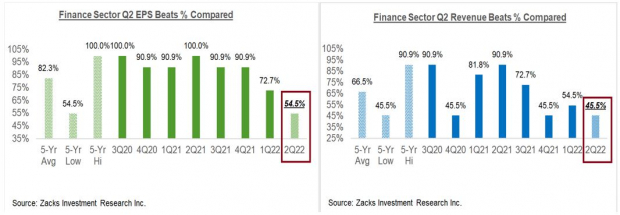
Image Source: Zacks Investment Research
Next week will bring results from all the regional banks in addition to Bank of America. Trends in loan portfolios and the outlook for costs will likely determine how the market responds to those results.
In addition to the regional banks, we will see a cross-section of earnings releases from other sectors, air carriers, railroad operators, and headline-grabbing operators like Netflix (NFLX), Tesla (TSLA), and Twitter (TWTR). In total, we will see Q2 results from more than 180 companies, including 71 S&P 500 members.
Q2 Earnings Season Scorecard
Through Friday, July 15th, we have Q2 results from 35 S&P 500 members that combined account for 13.3% of the market cap of the index. Total earnings for these 35 companies are down -10.5% on +9.3% higher revenues, with 68.6% beating EPS estimates and 62.9% beating revenue estimates.
The comparison charts below put the Q2 earnings and revenue growth rates for these index members in a historical context.
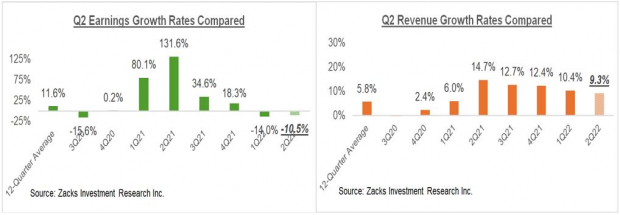
Image Source: Zacks Investment Research
The comparison charts below put the Q2 EPS and revenue beats percentages in a historical context.

Image Source: Zacks Investment Research
It is likely premature to draw any conclusions from this small and Finance-weighted sample, but it nevertheless gives us a good sense of the ongoing margin pressures. As you can see, year-over-year revenue growth of +9.3% for these companies has not been enough to produce comparable bottom-line growth. Also, the EPS and revenue beats percentages are tracking on the low side at this stage.
The Current Earnings Backdrop
The chart below shows current expectations (and actuals) on a quarterly basis.
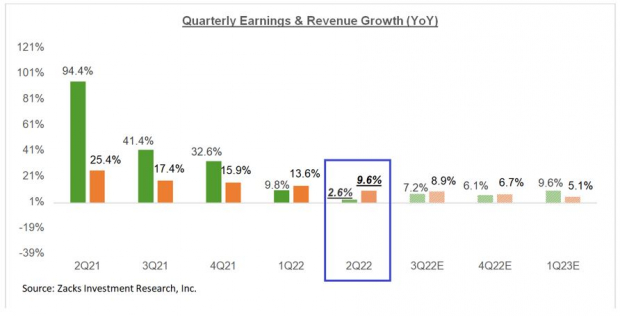
Image Source: Zacks Investment Research
Please note that the +2.6% earnings growth expected in 2022 Q2 is solely due to strong gains in the Energy sector. On an ex-Energy basis, Q2 earnings growth drops to a decline of -5.7%.
The chart below presents the earnings picture on an annual basis.
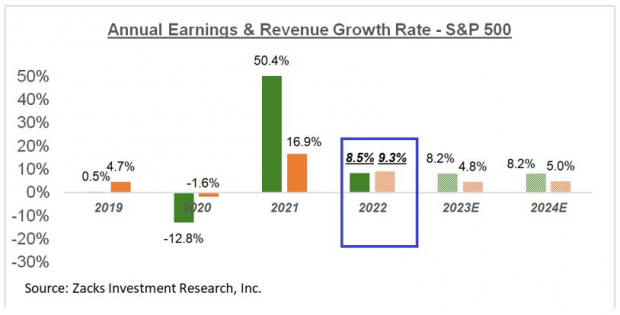
Image Source: Zacks Investment Research
More By This Author:
Q2 Earnings Season Gets Underway
Previewing JPMorgan and the Big Banks to Kick Off Q2 Earnings Season
Have Earnings Estimates Come Down Enough?
Disclosure: Zacks.com contains statements and statistics that have been obtained from sources believed to be reliable but are not guaranteed as to accuracy or completeness. References to any specific ...
more


